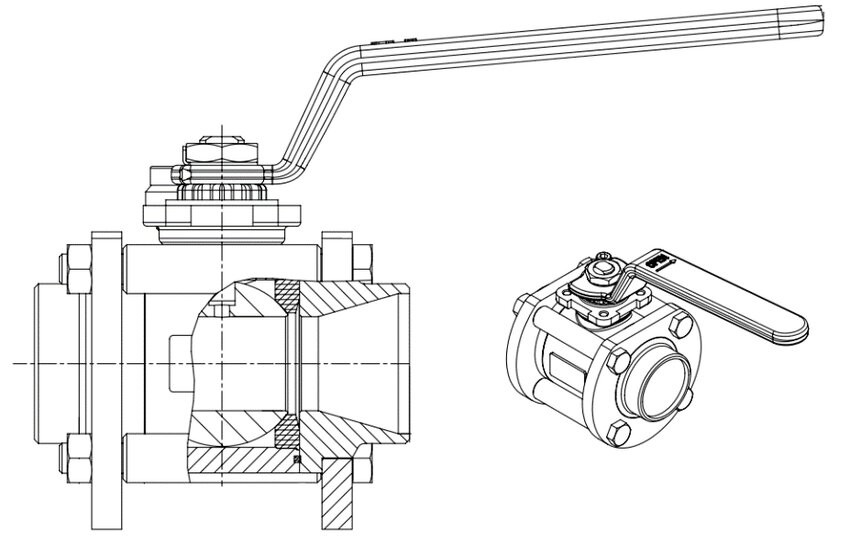Ball Valve Internal Leakage: Causes and Solutions
During the use or installation of ball valve, internal leakage issues may arise. This can be attributed to various reasons, including improper actions during the construction process and inadequate maintenance during operation. In this article, we will provide a detailed explanation of the various causes of internal leakage in ball valves and offer corresponding remedies.

Causes of Ball Valve Internal Leakage
The reasons for internal leakage in ball valves are diverse and can be broadly categorized into causes during construction and reasons for internal leakage during operation. Here are specific explanations:
1. Causes during Construction
2. Causes during Operation
Process of Handling Ball Valve Internal Leakage
The process of handling ball valve internal leakage requires systematic and sequential steps. The general steps for addressing internal leakage in ball valves are as follows:
In conclusion, ball valve internal leakage may result from construction issues and poor maintenance. The systematic approach includes adjusting limits, injecting grease, cleaning surfaces, and may involve repair or replacement to ensure proper valve function and sealing performance.

Causes of Ball Valve Internal Leakage
The reasons for internal leakage in ball valves are diverse and can be broadly categorized into causes during construction and reasons for internal leakage during operation. Here are specific explanations:
1. Causes during Construction
Improper Handling (Transport and Hoisting): Damage during transport or hoisting leading to overall valve damage and internal leakage.
Factory Treatment Issues: Lack of drying and corrosion prevention after water pressure application, causing corrosion and internal leakage.
Poor Construction Site Protection: Inadequate protection, allowing impurities like rainwater to enter the valve seat and cause leaks.
Incorrect Installation: Failure to inject lubricating grease, leading to impurities entering or burns during welding, causing internal leakage.
Incorrect Valve Position: Improper installation or welding without full-open valve position, damaging the ball and seat, resulting in internal leakage.
Scratches from Construction Residues: Sealing surface scratched by welding residues, causing leaks.
Time Constraints and Process Issues: Inadequate time constraints leading to misalignment, causing valve leakage.
Factory Treatment Issues: Lack of drying and corrosion prevention after water pressure application, causing corrosion and internal leakage.
Poor Construction Site Protection: Inadequate protection, allowing impurities like rainwater to enter the valve seat and cause leaks.
Incorrect Installation: Failure to inject lubricating grease, leading to impurities entering or burns during welding, causing internal leakage.
Incorrect Valve Position: Improper installation or welding without full-open valve position, damaging the ball and seat, resulting in internal leakage.
Scratches from Construction Residues: Sealing surface scratched by welding residues, causing leaks.
Time Constraints and Process Issues: Inadequate time constraints leading to misalignment, causing valve leakage.
2. Causes during Operation
Improper Operation or Non-Compliance: Incorrect operation or failure to follow maintenance procedures causing internal leakage.
Damage from Construction Residues: Construction residues causing scratches during operation, leading to internal leakage.
Improper Pipe Cleaning: Incorrect cleaning damaging the sealing surface and causing internal leakage.
Lack of Maintenance or Valve Movement: Extended periods without maintenance or movement causing lock-up and seal damage during valve operation.
Improper Valve Closure: Incorrect closure causing leakage even with a slight tilt.
Debris Accumulation in Stem Block: Prolonged use leading to debris accumulation, hindering valve rotation and causing leaks.
Restrictions on Actuators: Long-term corrosion or loosening causing inaccurate positioning and internal leakage.
Inaccurate Electric Actuator Positioning: Incorrect electric actuator positioning resulting in internal leakage.
Lack of Regular Maintenance: Insufficient maintenance causing dry and hardened sealing grease, hindering seat movement and causing seal failure.
Damage from Construction Residues: Construction residues causing scratches during operation, leading to internal leakage.
Improper Pipe Cleaning: Incorrect cleaning damaging the sealing surface and causing internal leakage.
Lack of Maintenance or Valve Movement: Extended periods without maintenance or movement causing lock-up and seal damage during valve operation.
Improper Valve Closure: Incorrect closure causing leakage even with a slight tilt.
Debris Accumulation in Stem Block: Prolonged use leading to debris accumulation, hindering valve rotation and causing leaks.
Restrictions on Actuators: Long-term corrosion or loosening causing inaccurate positioning and internal leakage.
Inaccurate Electric Actuator Positioning: Incorrect electric actuator positioning resulting in internal leakage.
Lack of Regular Maintenance: Insufficient maintenance causing dry and hardened sealing grease, hindering seat movement and causing seal failure.
Process of Handling Ball Valve Internal Leakage
The process of handling ball valve internal leakage requires systematic and sequential steps. The general steps for addressing internal leakage in ball valves are as follows:
1. Inspect Valve Limits: Check and adjust limits to resolve internal leakage.
2. Inject Lubricating Grease: Slowly inject grease to observe and stop leakage; monitor pressure gauge for internal leakage assessment.
3. Clean Sealing Surface and Seat: Inject cleaning solution, soak, open/close valve multiple times to dissolve solidified material.
4. Re-inject Grease, Remove Impurities: Re-inject grease, intermittently switch valve, and discharge impurities for effective lubrication.
5. Check Full-Closed Position: Inspect full-closed position; if leakage persists, consider injecting enhanced sealing grease for venting and sealing.
6. Repair or Replace Valve: If issues persist, consider repairing or replacing the valve, including seal replacement or component repair. Adjust steps based on specific circumstances for effective resolution.
2. Inject Lubricating Grease: Slowly inject grease to observe and stop leakage; monitor pressure gauge for internal leakage assessment.
3. Clean Sealing Surface and Seat: Inject cleaning solution, soak, open/close valve multiple times to dissolve solidified material.
4. Re-inject Grease, Remove Impurities: Re-inject grease, intermittently switch valve, and discharge impurities for effective lubrication.
5. Check Full-Closed Position: Inspect full-closed position; if leakage persists, consider injecting enhanced sealing grease for venting and sealing.
6. Repair or Replace Valve: If issues persist, consider repairing or replacing the valve, including seal replacement or component repair. Adjust steps based on specific circumstances for effective resolution.
In conclusion, ball valve internal leakage may result from construction issues and poor maintenance. The systematic approach includes adjusting limits, injecting grease, cleaning surfaces, and may involve repair or replacement to ensure proper valve function and sealing performance.

